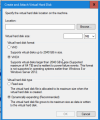I'm attempting to install a Windows Server 2022 Failover Cluster within my Proxmox environment to provide additional protection against operating system failures and to enable rolling updates for SQL Server.
I use a Fibre Channel SAN, with the LUNs presented on the Proxmox host.
The LUNs are mounted into the guest systems as follows (for example):
Unfortunately, Windows does not accept the disks with the message (translated from German):
The physical disk ... does not support the Query Data (VPD Descriptor according to SCSI Page 83h) required for failover clustering. Status: The request is not supported.
The Qemu drivers and guest tools are installed on Windows.
Are there any settings that can be adjusted to support VPD? Are there any alternative methods of integration (other than iSCSI), such as virtual WWNs?
I use a Fibre Channel SAN, with the LUNs presented on the Proxmox host.
The LUNs are mounted into the guest systems as follows (for example):
Code:
scsi2: /dev/mapper/sqlcluster-quorum,cache=none,shared=1,aio=native,discard=on,serial=QM000000005
scsihw: virtio-scsi-pciUnfortunately, Windows does not accept the disks with the message (translated from German):
The physical disk ... does not support the Query Data (VPD Descriptor according to SCSI Page 83h) required for failover clustering. Status: The request is not supported.
The Qemu drivers and guest tools are installed on Windows.
Are there any settings that can be adjusted to support VPD? Are there any alternative methods of integration (other than iSCSI), such as virtual WWNs?


